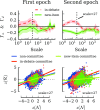Individuals, institutions, and innovation in the debates of the French Revolution
- PMID: 29666239
- PMCID: PMC5939074
- DOI: 10.1073/pnas.1717729115
Individuals, institutions, and innovation in the debates of the French Revolution
Abstract
The French Revolution brought principles of "liberty, equality, fraternity" to bear on the day-to-day challenges of governing what was then the largest country in Europe. Its experiments provided a model for future revolutions and democracies across the globe, but this first modern revolution had no model to follow. Using reconstructed transcripts of debates held in the Revolution's first parliament, we present a quantitative analysis of how this body managed innovation. We use information theory to track the creation, transmission, and destruction of word-use patterns across over 40,000 speeches and a thousand speakers. The parliament as a whole was biased toward the adoption of new patterns, but speakers' individual qualities could break these overall trends. Speakers on the left innovated at higher rates, while speakers on the right acted to preserve prior patterns. Key players such as Robespierre (on the left) and Abbé Maury (on the right) played information-processing roles emblematic of their politics. Newly created organizational functions-such as the Assembly president and committee chairs-had significant effects on debate outcomes, and a distinct transition appears midway through the parliament when committees, external to the debate process, gained new powers to "propose and dispose." Taken together, these quantitative results align with existing qualitative interpretations, but also reveal crucial information-processing dynamics that have hitherto been overlooked. Great orators had the public's attention, but deputies (mostly on the political left) who mastered the committee system gained new powers to shape revolutionary legislation.
Keywords: cognitive science; computational social science; cultural evolution; digital history; political science.
Copyright © 2018 the Author(s). Published by PNAS.
Conflict of interest statement
The authors declare no conflict of interest.
Figures


Similar articles
-
A Politics of Intellectual Property: Creating a Patent System in Revolutionary France.Technol Cult. 2020;61(4):1017-1044. doi: 10.1353/tech.2020.0109. Technol Cult. 2020. PMID: 33416662
-
The Norwegian Parliamentary Debates Dataset.Sci Data. 2025 Jan 2;12(1):4. doi: 10.1038/s41597-024-04142-x. Sci Data. 2025. PMID: 39747196 Free PMC article.
-
Sex education in Portugal.Plan Parent Eur. 1991 May;20(1):3-6. Plan Parent Eur. 1991. PMID: 12343180
-
Cosmopolitan political science.Br J Sociol. 2006 Mar;57(1):87-111. doi: 10.1111/j.1468-4446.2006.00095.x. Br J Sociol. 2006. PMID: 16506998 Review.
-
The politics of Piketty: what political science can learn from, and contribute to, the debate on Capital in the twenty-first century.Br J Sociol. 2014 Dec;65(4):678-95. doi: 10.1111/1468-4446.12110. Br J Sociol. 2014. PMID: 25516346 Review.
Cited by
-
How to Develop Reliable Instruments to Measure the Cultural Evolution of Preferences and Feelings in History?Front Psychol. 2022 Jul 18;13:786229. doi: 10.3389/fpsyg.2022.786229. eCollection 2022. Front Psychol. 2022. PMID: 35923745 Free PMC article.
-
Measuring the Volatility of the Political agenda in Public Opinion and News Media.Public Opin Q. 2021 Sep 18;85(2):493-516. doi: 10.1093/poq/nfab032. eCollection 2021 Summer. Public Opin Q. 2021. PMID: 34690575 Free PMC article.
-
The Diversity-Innovation Paradox in Science.Proc Natl Acad Sci U S A. 2020 Apr 28;117(17):9284-9291. doi: 10.1073/pnas.1915378117. Epub 2020 Apr 14. Proc Natl Acad Sci U S A. 2020. PMID: 32291335 Free PMC article.
-
How can big data shape the field of non-religion studies? And why does it matter?Patterns (N Y). 2021 Jun 11;2(6):100263. doi: 10.1016/j.patter.2021.100263. eCollection 2021 Jun 11. Patterns (N Y). 2021. PMID: 34179846 Free PMC article. Review.
-
Quantifying collective identity online from self-defining hashtags.Sci Rep. 2022 Sep 3;12(1):15044. doi: 10.1038/s41598-022-19181-w. Sci Rep. 2022. PMID: 36057691 Free PMC article.
References
-
- Jones BD, Baumgartner FR. The Politics of Attention: How Government Prioritizes Problems. Univ of Chicago Press; Chicago: 2005.
-
- Blei DM, Ng AY, Jordan MI. Latent Dirichlet allocation. J Mach Learn Res (JMLR) 2003;3:993–1022.
-
- Murdock J, Allen C, DeDeo S. Exploration and exploitation of Victorian science in Darwin’s reading notebooks. Cognition. 2017;159:117–126. - PubMed
-
- Benoit WL, Smythe MJ. Rhetorical theory as message reception: A cognitive response approach to rhetorical theory and criticism. Commun Stud. 2003;54:96–114.
-
- Harris RA. Reception studies in the rhetoric of science. Tech Commun Q. 2005;14:249–255.
Publication types
LinkOut - more resources
Full Text Sources
Other Literature Sources

